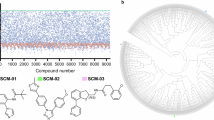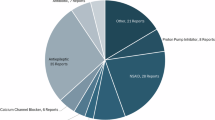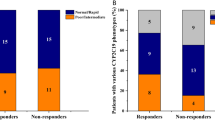Abstract
Aim:
To evaluate the potential drug-drug interactions between bifendate and cyclosporine, a substrate of CYP3A4, in relation to different CYP3A4*18B genotype groups.
Methods:
Eighteen unrelated healthy subjects (six CYP3A4*1*1, six CYP3A4*1/*18B, and six CYP3A4*18/*18B) were selected for this study. After repeated oral administration of a placebo or bifendate (three times daily for 14 d), the whole-blood level of cyclosporine was measured using high performance liquid chromatography-electrospray mass spectrometry (HPLC/ESI-MS). This study was carried out in a two-phase randomized crossover manner.
Results:
After the treatment with bifendate, the areas under the curve (AUC0–24 and AUC0–∞) decreased significantly by 9.7%±3.7% (P=0.01) and 19.2%±16.8% (P=0.001) in CYP3A4*1/*1 subjects, 11.3%±9.4% (P=0.03) and 10.5%±9.6% (P=0.043) in CYP3A4*1/*18B subjects, and 40.2%±14.7% (P=0.02) and 37.5%±15.8% (P=0.003) in CYP3A4*18B/*18B subjects. Meanwhile, the decreases in the AUC0–24 and AUC0–∞ values in the three groups were significantly different (using one-way analysis of variance, P=0.001 and P=0.001), and the change in the CYP3A4*18B/*18B group was greater than that in the other two groups. The oral clearance of cyclosporine was altered in all the subjects, with substantial increases by 10.2%±4.4% (P=0.004) in CYP3A4*1/*1 subjects, 14.0%±12.0% (P=0.048) in CYP3A4*1/*18B subjects, and 32.4%±21.7% (P=0.013) in CYP3A4*18B/*18B subjects.
Conclusion:
These results suggest that bifendate decreases the plasma concentration of cyclosporine in a CYP3A4 genotype-dependent manner.
Similar content being viewed by others
Log in or create a free account to read this content
Gain free access to this article, as well as selected content from this journal and more on nature.com
or
References
Liu GT . From the study of Fructus Schizandrae to the discovery of biphenyl dimethyl-dicarboxylate. Yao Xue Xue Bao 1983; 18: 714–20.
Liu GT, Wei HL, Song ZY . Further studies on the protective action of biphenyl dimethy-dicarboxylate (BDD) against experimental liver injury in mice. Acta Pharm Sin 1982; 17: 101–5.
Guan LP, Nan JX, Jin XJ, Jin QH, Kwak KC, Chai KY, et al. Protective effects of chalcone derivatives for acute liver injury in mice. Arch Pharm Res 2005; 28: 81–6.
Abdel-salam OM, Sleem AA, Morsy FA . Effect of biphenyldimethyl-dicarboxylate administrate alone or combined with silymarin in the CCl4 model of liver fibrosis in rats. Scientific World Journal 2007; 7: 1242–55.
Abdel-Hameid NA . Protective role of dimethyl diphenyl bicarboxylate (DDB) against erythromycin induced hepatotoxicity in male rats. Toxicol In Vitro 2007; 21: 618–25.
El-Beshbishy HA . The effect of dimethyl dimethoxy biphenyl dicarboxylate (DDB) against tamoxifen-induced liver injury in rats: DDB use is curative or protective. J Biochem Mol Biol 2005; 38: 300–6.
Liu KT, Cresteil T, Le Provost E, Lesca P . Specific evidence that schizandrins induce a phenobarbital-like cytochrome P-450 form separated from rat liver. Biochem Biophys Res Commun 1981; 103: 1131–7.
Liu ZY, Wang YL, Zhou ZH . Effect of bifendate on pharmacokinetics of cyclosporine A in rabbits. Chin Hosp Pharm J 2002; (22): 8.
el-Sawy SA, el-Shafey AM, el-Bahrawy HA . Effect of dimethyl diphenyl bicarboxylate on normal and chemically-injured liver. East Mediterr Health J 2002; 8: 95–104.
Lu H, Li Y . Effects of dimenthyl diphenyl bicarboxylate on the metabolism and hepatotoxicity of aflatoxin B1 in rats. Acta Pharm Sin 2002; 37: 753–7.
Awni WM . Pharmacodynamic monitoring of cyclosporine. Clin Pharmacokinet 1992; 23: 428–48.
Blanchet B . Therapeutic monitoring of immunosuppressive drugs: interest of calcineurin activity assessment in liver transplantation. Ann Pharm Franc 2008; 66: 96–101.
Lin CS, Boltz RZ, Siekierka JJ, Sigal NH . FK-506 and cyclosporine A inhibit highly similar signal transduction pathways in human T lymphocytes. Cell Immunol 1991; 133: 269–84.
Sehajpal PK, Sharma VK, Ingulli E, Stenzel KH, Suthanthiran AN . Synergism between the CD3 antigen- and CD2 antigen-derived signals: exploration at the level of induction of DNA-binding proteins and characterization of the inhibitory activity of cyclosporine. Transplantation 1993; 55: 1118–24.
Buchler M, Johnston A . Seeking optimal prescription of cyclosporine ME. Ther Drug Monit 2005; 27: 3–6.
Ozbay A, Karamperis N, Jorqensen KA . A review of the immunosuppressive activity of cyclosporine metabolites: new insights into an old issue. Curr Clin Pharmacol 2007; 2: 244–8.
Brunet M, Crespo M, Millan O, Seron D, Torreqrisa V, Jimenez O, et al. Pharmacokinetics and pharmacodynamics in renal transplant recipients under treatment with cyclosporine and Myfortic. Transplant Proc 2007; 39: 2160–2.
Kahan BD . Cyclosporine. N Engl J Med 1989; (321): 1725–38.
Dunn CJ, Wagstaff AJ, Perry CM, Plosker GL, Goa KL . Cyclosporine: an updated review of the pharmacokinetic properties, clinical efficacy and tolerability of a microemulsion-based formulation (neoral) 1 in organ transplantation. Drugs 2001; 61: 1957–2016.
Chowbay B, Cumaraswamy S, Cheung YB, Zhou Q, Lee EJ . Genetic polymorphisms in MDR1 and CYP3A4 genes in Asians and the influence of MDR1 haplotypes on cyclosporine disposition in heart transplant recipients. Pharmacogenetics 2003; 13: 89–95.
Hesselink DK, Van Schaik RH, Van der Heiden IP, Van der Werf M, Greqoor PJ, Lindemans J, et al. Genetic polymorphisms of the CYP3A4, CYP3A5, and MDR-1 genes and pharmacokinetics of the calcineurin inhibitors cyclosporine and tacrolimus. Clin Pharmacol Ther 2003; 74: 245–54.
Hebert MF . Contributions of hepatic and intestinal metabolism and P-glycoprotein to cyclosporine and tacrolimus oral drug delivery. Adv Drug Deliv Rev 2997; 27: 201–14.
Pachecka J, Tomaszewski P, Kubiak-Tomaszewska G . Cytochrome P450 polymorphism-molecular, metabolic and pharmacogenetic aspects. I. Mechanisms of activity of cytochrome P450 monoxygenases. Acta Pol Pharm 2008; 65: 303–6.
Thummel KE, Wilkinson GR. In vitro and in vivo interactions involving human CYP3A. Annu Rev Pharmacol Toxicol 1998; 38: 389–430.
Ozdemir V, Kalow W, Tang BK, Paterson AD, Walker SE, Endrenyi L, et al. Evaluation of the genetic component of variability in CYP3A4 activity: a repeated drug administration method. Pharmacogenetics 2000; 10: 373–88.
Fukushima-uesaka H, Saito Y, Watanabe H, Shiseki K, Saeki M, Nakamura T, et al. Haplotypes of CYP3A4 and their close linkage with CYP3A5 haplotypes in a Japanese population. Hum Mutat 2004; 23: 100.
Kronbach T, Fischer V, Meyer UA . Cyclosporine metabolism in human liver: identification of a cytochrome P-450 III gene family as the major cyclosporine-metabolizing enzyme explains interactions of cyclosporine with other drugs. Clin Pharmacol Ther 1988; 43: 630–5.
Aoyama T, Yamano S, Waxman DJ, Lapenson DP, Meyer UA, Fischer V, et al. Cytochrome P-450 hPCN3, a novel cytochrome P-450 IIIA gene product that is differentially expressed in adult human liver. cDNA and deduced amino acid sequence and distinct specificities of cDNA-expressed hPCN1 and hPCN3 for the metabolism of steroid hormones and cyclosporine. J Biol Chem 1989; 264: 10388–95.
Utecht KN, Hiles JJ, Kolesar J . Effect of genetic polymorphisms on the pharmacokinetics of calcineurin inhibitors. Am J Health Syst Pharm 2006; 63: 2340–8.
Zhu M, Yeung RY, Lin KF, Li RC . Improvement of phase I drug metabolism with Schisandra chinensis against CCL4 hepatotoxicity in a rat model. Planta Med 2000; 66: 521–5.
Mu Y, Zhang J, Zhang S, Zhou HH, Toma D, Ren S, et al. Traditional Chinese medicines Wu Wei Zi (Schisandra chinensis Baill) and Gan Cao (Glycyrrhiza uralensis Fisch) activate pregnane X receptor and increase warfarin clearance in rats. J Pharmacol Exp Ther 2006; 316: 1369–77.
Kato M . Intestinal first-pass metabolism of CYP3A4 substrates. Drug Metab Pharmacokinet 2008; 23: 87–94.
Wang SM, Lai MK, Chueh SC, Tai HC, Chung SD . Optimal C2 concentration of cyclosporine corrected with good efficacy and safety in Asian kidney transplant recipients. Transplant Proc 2008; 40: 2243–4.
Morris RG . Cyclosporine therapeutic drug monitoring — an established service revisited. Clin Biochem Rev 2003. 24: 33–46.
Dahan A, Altman H . Food-drug interaction: grapefruit juice augments drug bioavailability-mechanism, extent and relevance. Eur J Clin Nut 2004; 58: 1–9.
Lorusso P, Heath EI, McGreivy J, Sun YN, Melara R, Yan L, et al. Effect of coadministration of ketoconazole, a strong CYP3A4 inhibitor, on pharmacokinetics and tolerability of motesanib diphosphate (AMG 706) in patients with advanced solid tumors. Invest New Drugs 2008; 26: 455–62.
Singh YN . Potential for interaction of kava and St. John's wort with drugs. J Ethnopharmacol 100: 108–13
Pollard SG . Pharmacologic monitoring and outcomes of cyclosporine. Transplant Proc 2004; 36: 404–7.
Venkataramanan R, Komoroski B, Strom S . In vitro and in vivo assessment of herb drug interactions. Life Sci 2006; 78: 2105–15.
Hu WY, Li YW, Hou YN, He K, Chen JF, But PP, et al. The induction of liver microsomal cytochrom P450 by Glycyrrhiza uralensis and glycyrrhetinic acid in mice. Biomed Environ Sci 1999; 12: 10–4.
Lin G, Nnane IP, Cheng TY . The effects of pretreatment with glycyrrhizin and glycyrrhetinic acid on the retrorsine-induced hepatotoxicity in rats. Toxicon 1999; 37: 1259–70.
Thummel KE, Wilkinson GR. In vivo and in vitro drug interactions involving human CYP3A. Annu Rev Pharmacol Toxicol 1998; 38: 389–430.
Hsieh KP, Lin YY, Cheng CL, Lai ML, Lin MS, Siest JP, et al. Novel mutations of CYP3A4 in Chinese. Drug Metab Dispos 2001; 29: 268–73.
Fukushima-Uesaka H, Saito Y, Watanabe H, Shiseki K, Saeki M, Nakamura T, et al. Haplotypes of CYP3A4 and their close linkage with CYP3A5 haplotypes in a Japanese population. Hum Mutat 2004; 23: 100.
Acknowledgements
This work was supported by research grants from the National Natural Science Foundation of China (No 30672497), the China Medical Board of New York (grant No 01-755), and the Hunan Health Research Foundation of Traditional Chinese Medicine (grant No 204041).
Author information
Authors and Affiliations
Corresponding authors
Rights and permissions
About this article
Cite this article
Zeng, Y., He, Yj., He, Fy. et al. Effect of bifendate on the pharmacokinetics of cyclosporine in relation to the CYP3A4*18B genotype in healthy subjects. Acta Pharmacol Sin 30, 478–484 (2009). https://doi.org/10.1038/aps.2009.27
Received:
Accepted:
Published:
Issue date:
DOI: https://doi.org/10.1038/aps.2009.27
Keywords
This article is cited by
-
Association of CYP3A polymorphisms with the pharmacokinetics of cyclosporine A in early post-renal transplant recipients in China
Acta Pharmacologica Sinica (2012)
-
Pharmacogenetics in Kidney Transplantation
Molecular Diagnosis & Therapy (2012)



